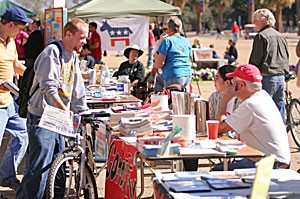Former Justice Sandra Day O’Connor has taken up a new profession since retiring Tuesday from the U.S. Supreme Court: teaching UA students about the practices and procedures of the highest court in the land.
Students lined up outside the James E. Rogers College of Law yesterday afternoon to grab the closest seats to the honorable justice, who will be co-teaching half of the curriculum for the 10-day course law 695H: The Supreme Court.
Though she has taught a few one-hour classes at different institutions nationwide, O’Connor said this is the first time she will be teaching four to five classes for one particular course.
“”I am very excited,”” O’Connor said.
In addition to giving students an insider’s look at how the Supreme Court operates, the course also emphasizes the roles of the clerks, foreign law and how the court deals with changing administration, said Nancy Stanley, associate director for external affairs in the College of Law.
Instructing with O’Connor is her former colleague and distinguished visiting faculty fellow RonNell Andersen Jones, who worked as O’Connor’s law clerk from 2003 to 2004, Stanley said.
Though the class is limited to second- and third-year law students, 178 students are enrolled, which is more than one-third of the college’s student body of 450, said Toni Massaro, dean of the College of Law.
“”Every chair is full,”” Massaro said. “”Imagine at 8:15 this morning you’re studying cases and then at noon you get to meet one of the justices. This is as good as it gets for a law student.””
It’s also one of the more exciting classes offered at the UA thus far, said Mary Beth Canty, a third-year law student.
Before class began, Canty said it may not sound appropriate to only take a course because of the professor, but the chance to be near O’Connor is an opportunity she would never give up.
Afterward, Canty walked out of the room smiling and said, “”This has been the highlight of my college career.””
The class also gives students a rare insight into how it felt to be the first woman on the Supreme Court, a topic that Ifeoma Ononye, a master’s law student, said she is interested in learning more about.
And while O’Connor was enthusiastic about her role in the court, it was also nice to hear she was unhappy that the number of women on the court has decreased by 50 percent because of her retirement, said Obinna Ogbunamiri, a third-year law student.
“”It was great to hear how disappointed she was about that. It was really a great insight and it gave a different perspective about managing the court,”” Ogbunamiri said. “”This was a historic event for me.””
If all goes well, Massaro said she hopes O’Connor will accept another invitation to teach in the future.
O’Connor, who grew up on a ranch in Greenlee County in Southeast Arizona, said if her experience with co-teaching this course is positive, then she may consider coming back.
“”I’m very happy to be able to be back home,”” O’Connor said, smiling. “”We’ll see if we do it again.””









